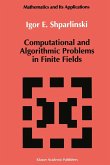ThecreationofpublickeycryptographybyDi?eandHellmanin1976andthe subsequent invention of the RSA public key cryptosystem by Rivest, Shamir, and Adleman in 1978 are watershed events in the long history of secret c- munications. It is hard to overestimate the importance of public key cr- tosystems and their associated digital signature schemes in the modern world of computers and the Internet. This book provides an introduction to the theory of public key cryptography and to the mathematical ideas underlying that theory. Public key cryptography draws on many areas of mathematics, including number theory, abstract algebra, probability, and information theory. Each of these topics is introduced and developed in su?cient detail so that this book provides a self-contained course for the beginning student. The only prerequisite is a ?rst course in linear algebra. On the other hand, students with stronger mathematical backgrounds can move directly to cryptographic applications and still have time for advanced topics such as elliptic curve pairings and lattice-reduction algorithms. Amongthemanyfacetsofmoderncryptography,thisbookchoosestoc- centrate primarily on public key cryptosystems and digital signature schemes. This allows for an in-depth development of the necessary mathematics - quired for both the construction of these schemes and an analysis of their security. The reader who masters the material in this book will not only be well prepared for further study in cryptography, but will have acquired a real understanding of the underlying mathematical principles on which modern cryptography is based.
From the reviews:
"The book is devoted to public key cryptography, whose principal goal is to allow two or more people to exchange confidential information ... . The material is very well organized, and it is self-contained: no prerequisites in higher mathematics are needed. In fact, everything is explained and carefully covered ... . there is abundance of examples and proposed exercises at the end of each chapter. ... This book is ideal as a textbook for a course aimed at undergraduate mathematics or computer science students." (Fabio Mainardi, The Mathematical Association of America, October, 2008)
"This book focuses on public key cryptography ... . Hoffstein, Pipher, and Silverman ... provide a thorough treatment of the topics while keeping the material accessible. ... The book uses examples throughout the text to illustrate the theorems, and provides a large number of exercises ... . The volume includes a nice bibliography. ... Summing Up: Highly recommended. Upper-division undergraduate through professional collections." (C. Bauer, Choice, Vol. 46 (7), March, 2009)
"For most undergraduate students in mathematics or computer science (CS), mathematical cryptography is a challenging subject. ... it is written in a way that makes you want to keep reading. ... The authors officially targeted the book for advanced undergraduate or beginning graduate students. I believe that this audience is appropriate. ... it could even be used with students who are just learning how to execute rigorous mathematical proofs. ... I strongly believe that it finds the right tone for today's students ... ." (Burkhard Englert, ACM Computing Reviews, March, 2009)
"The exercises and text would make an excellent course for undergraduate independent study. ... This is an excellent book. Hoffstein, Pipher and Silverman have written as good a book as is possible to explain public key cryptography. ... This book would probably be best suited for a graduate course that focused on public key cryptography, for undergraduate independent study, or for the mathematician who wants to see how mathematics is used in public key cryptography." (Jintai Ding and Chris Christensen, Mathematical Reviews, Issue 2009 m)
"The book is devoted to public key cryptography, whose principal goal is to allow two or more people to exchange confidential information ... . The material is very well organized, and it is self-contained: no prerequisites in higher mathematics are needed. In fact, everything is explained and carefully covered ... . there is abundance of examples and proposed exercises at the end of each chapter. ... This book is ideal as a textbook for a course aimed at undergraduate mathematics or computer science students." (Fabio Mainardi, The Mathematical Association of America, October, 2008)
"This book focuses on public key cryptography ... . Hoffstein, Pipher, and Silverman ... provide a thorough treatment of the topics while keeping the material accessible. ... The book uses examples throughout the text to illustrate the theorems, and provides a large number of exercises ... . The volume includes a nice bibliography. ... Summing Up: Highly recommended. Upper-division undergraduate through professional collections." (C. Bauer, Choice, Vol. 46 (7), March, 2009)
"For most undergraduate students in mathematics or computer science (CS), mathematical cryptography is a challenging subject. ... it is written in a way that makes you want to keep reading. ... The authors officially targeted the book for advanced undergraduate or beginning graduate students. I believe that this audience is appropriate. ... it could even be used with students who are just learning how to execute rigorous mathematical proofs. ... I strongly believe that it finds the right tone for today's students ... ." (Burkhard Englert, ACM Computing Reviews, March, 2009)
"The exercises and text would make an excellent course for undergraduate independent study. ... This is an excellent book. Hoffstein, Pipher and Silverman have written as good a book as is possible to explain public key cryptography. ... This book would probably be best suited for a graduate course that focused on public key cryptography, for undergraduate independent study, or for the mathematician who wants to see how mathematics is used in public key cryptography." (Jintai Ding and Chris Christensen, Mathematical Reviews, Issue 2009 m)
"This book explains the mathematical foundations of public key cryptography in a mathematically correct and thorough way without omitting important practicalities. ... I would like to emphasize that the book is very well written and quite clear. Topics are well motivated, and there are a good number of examples and nicely chosen exercises. To me, this book is still the first-choice introduction to public-key cryptography." (Klaus Galensa, Computing Reviews, March, 2015)
"This is a text for an upper undergraduate/lower graduate course in mathematical cryptography. ... It is very well written and quite clear. Topics are well-motivated, and there are a good number of examples and nicely chosen exercises. ... An instructor of a fairly sophisticated undergraduate course in cryptography who wants to emphasize public key cryptography should definitely take a look at this book." (Mark Hunacek, MAA Reviews, October, 2014)
"This is a text for an upper undergraduate/lower graduate course in mathematical cryptography. ... It is very well written and quite clear. Topics are well-motivated, and there are a good number of examples and nicely chosen exercises. ... An instructor of a fairly sophisticated undergraduate course in cryptography who wants to emphasize public key cryptography should definitely take a look at this book." (Mark Hunacek, MAA Reviews, October, 2014)








